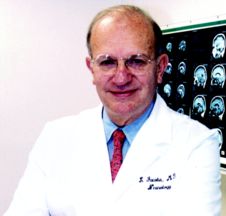A Tribute to Lawrence Jacobs, MD

The American Society of Neuroimaging has now lost three past presidents. The first was Bill Oldendorf in December 1992, Ilydio Polachini in June 2001 and now the latest, Lawrence Jacobs at the age of 63, on November 2, 2001. All three were brilliant and unique individuals who left a legacy for young neurologists and imagers to come. They were close friends of many in our society, including myself. Through the pain of our losses, we write to remember the vibrancy of these men and to crystallize enduring relationships, which will live on in all our memories.
I first met Larry in 1975, at an organizational meeting of a new society in Buffalo, sponsored by the Dent Neurological Institute. It was called the Society for Computerized Tomography and Neuroimaging (SCTNI), which later became the American Society of Neuroimaging. We clicked instantly and my first impression of a very friendly and amusing man was borne out. His humor could be irreverent at times, although always good-natured. He was true to form on the day he died at Sloan-Kettering Memorial Hospital. An intern walked in and politely introduced himself to Dr. Jacobs. Larry’s wife, Pam, recalls him razzing the intern by replying, “ young man, how old are you?”
He was Chairman of the Department of Neurology and Head of the Jacobs Neurological Institute at Buffalo General Hospital and the State University of New York at Buffalo. He was a member of many medical organizations including the AAN, ANA and the AUPN. He received many awards for his work in MS and traveled the world widely lecturing on his work. He was a Board Member of the AAN Education and Research Foundation and contributed generously to this and many other foundations and projects. He was a reviewer and on the editorial board of 11 peer reviewed journals. He had support for his research from the NIH among other organizations and foundations.
From 1977 to 1982, he was the program chairman for the ASN and served as the fifth President from 1986 through 1988. He had great organizational and leadership skills and ran the Society with utmost efficiency. He and his colleagues at the Dent were the leaders in the field and presented many papers, first on CT and then later MRI. For five years in the 1980’s, he chaired the Imaging Course of the American Academy of Neurology, which continued to draw 300+ attendees as it had in the past. He also served on the faculty for the same course in prior years and for years after his chairmanship.
Early on he focused on neuroophthalmology because of his residency training at Mt. Sinai with Dr. Morris Bender. Larry always raved about Dr. Bender and his teaching. This lead to his early papers on eye movements and later his interest in imaging of the orbits and then his textbook on CT of the Orbit and Sella Turcica with Leon Weisberg. In addition to the latter, he published 95 articles in peer-reviewed journals, many book chapters, review articles and abstracts too numerous to mention.
In the mid-eighties, he developed an interest in Multiple Sclerosis and as he developed important research in this area, his attention drifted away from the ASN. His work on the CHAMPS study was published as the lead article in the New England Journal of Medicine in September 2000. This work showed that interferon prevented the conversion to clinically definite MS. Later the Harvard Health Letter named this article among the top 10 most important medical advances of the year. I asked a mutual friend to fill me in on his activities in this area. This is the response I received from Howard Zwibel MD, a well-known neurologist in the field of MS. I felt I could ask him because I was his camp counselor at a children’s camp in West Virginia, fifty years ago. This is what Howard wrote:
“Some of us are fortunate in our careers to excel scientifically and some of us are fortunate to be thought of as good clinicians. Larry accomplished both. He clearly was the father of one of our widely accepted therapies for relapsing remitting MS- Avonex -using it initially intrathecally and then intramuscularly. Thousands of patients worldwide have benefited from its use and have had their disease course altered. Larry was also a respected clinician taking care of patients at a time when he could have transferred that responsibility to others. When I would call, it always seemed that he was seeing patients. Each time I would see him at a meeting he always asked about my well-being and my family. He was truly a complete physician. “
I had dinner with Larry at his home in Buffalo in December 2000. His department was there as well as Pam. We all gave toasts and remembered the early days of imaging. The love and respect his colleagues had for him was palpable. We had lunch at the Academy meeting in April 2001 with several of his faculty and, as always, he was the life of the party.
To Pam, Chris, Luke, Larry Jr., Jessica, Liz and Molly - I say it was a privilege to have known him. These words reflect only faintly the affection and admiration in which he is held.
Jack O. Greenberg M.D.
Philadelphia, Pa.
November 18, 2001
